How I demonstrated Inclusive Education in my 490 Practicum
During my 490 practicum I found myself in a classroom with a wide range on learners. Within the first visit to the class I knew one of my big goals for this practicum would be for me to focus my lessons on differentiating the learning and providing every student the opportunity to demonstrate their abilities. Fostering an inclusive learning environment is a big part of my philosophy. I believe that we as the educators need to meet every student on their level and address their needs as individuals. Placing a student in the hall to work separately or providing them with an iPad to keep them busy while you teach the “rest” of the class should not be a system we see in our classrooms. Each student comes to our school to learn and by providing them with a different learning routine you may be benefiting their academic development to an extent. However, I believe that our students come to our schools to do more then learn, they come to be a part of something bigger then themselves. They come to build relationships, find a sense of belonging, develop the skills needed to be a good person in this word, and yes, they also come to learn. If our classrooms are not modeling an inclusive environment, we are not giving them the opportunity to learn in all areas of life. This is why I took my goal of creating an inclusive classroom profoundly serious. I found ways to provide lessons that every student would be able to do, and I made sure that every student was involved in the same learning experience, and everyone’s learning intention was the same.
Visual and hands on learning about our ecosystem
During this lesson, each student was given a part of the ecosystem whether that be a tree, deer, wolf, dirt, sun etc. Students then would pass the yarn around and say how their thing related to someone else within the circle. So, if they were a fox they could pass to the rabbit and say, “I eat rabbits.” Eventually we had an entire ecosystem web providing students with a visual of how each thing within the ecosystem is important and connected. To end the lesson, I then started cutting the yarn and asking students what would happen if all the trees died, or if all the wolves were gone. Students where able to reflect on their ideas, but by cutting the yarn they where able to visually see that when one thing is taken from the ecosystem the entire web begins to unravel. This lesson was incredibly fun, and every student was engaged in the conversation.
How I differentiated the learning: Knowing my students I knew that if I just told them you are a tree they would not have been able to focus on the learning intention but instead would focus on remembering what their thing was, so I provided everyone with a tag taped to their shirt that had their assigned part of the ecosystem. To take this further I used words and pictures for my students who needed that extra support reading. This way all learners where able to do this activity independently without having to ask for help on what a word said. This lesson had everyone actively involved in the conversation and allowed students to share ideas with each other and form their thinking from ideas shared by fellow classmates. This lesson also reached my visual learners who needed the hands-on learning to solidify the concept. I found this lesson to be successful as all learners where able to take something away and demonstrate their learning at a level that suited them best.

Each student can easily see and understand what they are supposed to be and what other people in the circle are.
Read and write around the room
During my 490 practicum I did two lessons that had students finding information around the room and recording it. The first lesson focused on ecosystems, students moved around the room and answered questions based on the topics posted around the room. Again, I believe every student should be involved in the learning, so I created 3 different levels for students to participate in. Each color of paper had a different degree of challenge, by doing this I allowed each student the ability to participate in the learning with a level that best suited them. I found this lesson to be successful as every student was engaged in their own learning. Students where up and moving and able to collaborate with one another and build upon their understanding together. The students who needed the extra support were able to work on this independently and were actively engaged in the same lesson. The students enjoyed this lesson so much that I created another read and write around the room for an English language arts lesson. With previous lessons focusing on descriptive language students had to find the write ups around the room and record the different descriptive words used in the paragraph. Again, this lesson was able to reach every learner. Each student was engaged and participating in the lesson. Each of these lessons the students were able to complete the same learning intentions they just had the difficulty adjusted to fit them. Meeting our students where they are at and providing them with an opportunity to demonstrate their learning is key in creating an inclusive classroom.

All students were engaged as they moved around the room recording their findings.
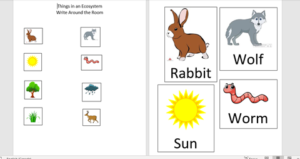
A sample of on of the levels used to reach all learners.

Reaching every student where they are at.
Shape Bingo
During my 490 practicum students where learning about geometry in math. A majority of the class was working in the same jump math books and learning their lessons together. However, some learners were on a different math program to reach their needs. I understood why they were not on the same program, but I struggled, as often these students where ignored or sent out of the room to learn separately during math time. I wanted to find some lessons I could teach that aligned with the classes learning but involved every student. Shape bingo ended up being very successful because every student was excited to play and everyone was able to play despite their level of math understandings. With this game I would read a description of a shape and the students would raise their hand if they knew what the shape was, I would then show everyone the shape and they could mark it off their bingo board. Even though not every learner raised their hand with the answer they where still engaged in the learning and discussion of the shapes. I even noticed that after playing a couple of rounds the students who normally did not raise their hands where starting to pick up on the definitions of the shapes and eventually gained the confidence to raise their hand and answer. Also, if you play a game the students are going to be excited and willing to try something they originally might think is to hard, so I always recommend finding ways to fit play into the learning.

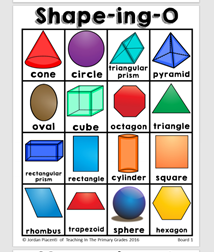
Bring play into your learning is a great way to get all students actively involved in the learning.
Shapes around the room
This lesson was a lot like the read and write around the room, only now students where writing everything they knew about the shapes we had been learning in geometry. Around the room were different shapes and the students had to take the papers with the matching shape and demonstrate what they knew about these shapes, I.E how many sides, how many parallel lines etc. Again, I provided the students with different levels, only this time to try something new I decided to let them pick their level based on what they thought they were able to do. I was impressed to see all the students were able to pick the level that they found would work best for them, and many took the risk to challenge themselves with the hardest level. Again, this lesson was successful as every student was actively involved and able to demonstrate their learning in a way that suited them. A previous lesson I had done involved students building their own 3D shapes students where then able to take the information we had learned building these shapes and use this as a tool to help demonstrate their learning. Connecting previous knowledge and hands on experiences helped make the concept more concrete and helped them further understand the shapes.
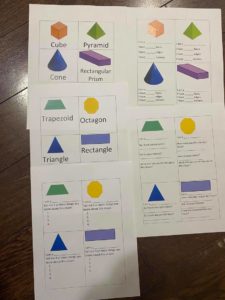
The 3 different levels students were able to chose from to best demonstrate their understanding of shapes.
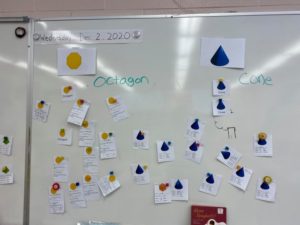
Students were able to use information someone else had put on the board as a spring board to help them share their own understanding of shapes.
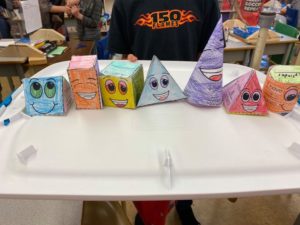
Previously constructed 3D shapes that students used as a tool to help them demonstrate their learning.
Often when we think of inclusive classrooms we think of adjusting our teaching to reach every student on an academic level. However, providing an inclusive environment is more then just content and concepts we must be providing students with relevant learning that relates to them and helps them feel a sense of belonging. I was able to implement this in my 490 practicum by providing lessons that focused on the Indigenous culture and the local indigenous peoples. Students in the class who were not seeing themselves represented in their learning were able to connect to the lessons in a personal way. Providing students with learning opportunities where they can see themselves and feel the connection in a concrete way will help them succeed in all the learning that takes place.
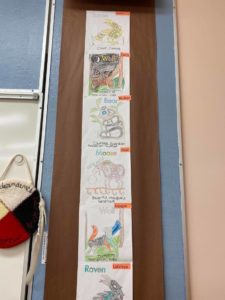
We made a classroom totem pole where students where able to pick an animal whose characteristics best represented them. Students felt a sense of identity and belonging within our classroom community.
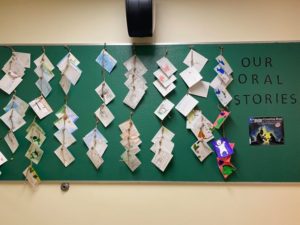
We then took our animal from our totem pole and created oral stories about our animals. Using the book “Knots on a Counting Rope” we were able to dive into oral stories and the traditional role they play with the First Peoples.
This entire 490 practicum was a great learning experience as it allowed me the opportunity to differentiate the learning in every aspect of my lessons. I quickly learned that in order to reach every student and meet them where they are at you are going to have to put in the extra work. I also learned that the extra work is so worth it as every student in the class feels involved in the learning and a part of the school community. Not only was every student able to learn but they were able to see what it means to be a part of a community, and they were given the opportunity to build those relationships in a safe inclusive environment. Our students should not be coming into the classrooms to fit your needs instead we as educators need to be finding ways to teach in a way that fits them as a learner. As I look towards my next practicum, I cant help but feel hopeful and encouraged in my abilities to create an inclusive classroom.